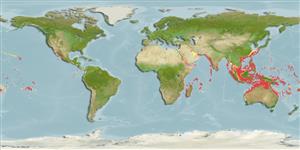分類 / Names
俗名 | 同種異名 | Catalog of Fishes(屬, 種) | ITIS | CoL | WoRMS | Cloffa
Teleostei >
Dactylopteriformes (Flying gurnards)
刺魚目 (Flying gurnards) >
Pegasidae (Seamoths)
海蛾魚科 (Seamoths)
Etymology: Eurypegasus: Greek, eurys = long + Greek, Pegasus, pege = springs of Ocean near which Medusa was said to have been killed; the winged horse, sprung from the blood of Medusa (Ref. 45335); draconis: From the Latin word 'draco' meaning fabulous, lizard-like animal..
More on author: Linnaeus.
Environment: milieu / climate zone / depth range / distribution range
生態學
海洋; 半鹹淡水 居於水底的; 深度上下限 3 - 91 m (Ref. 26165), usually 35 - 90 m (Ref. 33989). 熱帶; 32°N - 32°S
Indo-Pacific: Red Sea and South Africa (Ref. 4264) to Marquesan and Society Islands, north to southern Japan, south to Australia and Lord Howe Island; throughout Micronesia.
印度-太平洋: 對馬貴斯群島與社會群島的紅海與南非 (參考文獻 4264), 北至日本南部, 南至澳洲與羅得豪島; 在密克羅尼西亞各處。
大小 / 重量 / 年齡
Maturity: Lm ? range ? - ? cm
Max length : 10.0 cm TL 雄魚/尚未辨別雌雄; (Ref. 3132)
背棘 (總數): 0; 背的軟條 (總數): 5; 臀棘 0; 臀鰭軟條: 5; 脊椎骨: 19 - 22. Color in life variable; body usually light to dark brown, with dorsal and lateral area darker than ventral surface. Pectoral fins hyaline, distal margin white and spotted. Pelvic fin spine and 1st ray forming an elongate, tentacular structure. 3 pairs of dorsolateral body plates; 4 pairs of ventrolateral body plates; tail rings 8 (rarely 9), mobile. A pair of deep pits posterior to orbit. Suborbital shelf concave, eye visible in ventral view. Ventral ridges of rostrum greatly expanded than dorsal ridges, each with laterally directed denticles. Anal papilla absent.
顏色活著時可變的; 身體通常淡色到深褐色的, 有背部的與側面的區域比腹面顏色更深。 胸鰭透明又末梢部的邊緣白色與有斑點的。 腹鰭棘與第一鰭條形成細長又觸絲的結構。 三對體背外側的碟; 四對體腹外側的碟; 尾環 8(很少地 9), 移動的。 一對深的窪凹在眼窩後面。 眶下架凹曲, 眼看得見的由腹面觀之。 喙的腹面脊非常擴大了勝於背部的脊,每個具有朝向側面的細齒。 肛門的乳突不存在。
Inhabit lagoons often among algal or seagrass beds (Ref. 5503). Found on sand or silt bottoms, frequently in bays or estuaries (Ref. 3132). They are opportunistic feeders that collect mainly epifaunal and interstitial invertebrate prey, e.g., crustaceans and worms from the sediment-water interface (Ref. 31134). Shed their skin in one piece with a rapid jump periodically to rid themselves of accumulated ballast (Ref. 31134). Adults usually in pairs on muddy substrates (Ref. 48635). Has a monogamous mating system with close-pair bonding (Ref. 90102).
棲息於潟湖常見於海藻或海草床之中.(參考文獻 5503) 棲息於沙子或淤泥底了, 時常在海灣或河口.(參考文獻 3132) 他們是主要採集表生種而間質的無脊椎動物獵物,例如 , 甲殼動物與蠕蟲從沉澱物-水的介面的隨機捕食者。 (參考文獻 31134) 在一塊中脫落他們的皮膚用一個週期性的快速跳躍累積的壓載物免除他們自己。 (參考文獻 31134) 在泥質底部上成魚通常成對出現。 (參考文獻 48635)
Life cycle and mating behavior
成熟度 | 繁殖 | 產卵場 | 卵 | 孕卵數 | 仔魚
Are broadcast spawners. In several aquaria, spawning is observed as pairs rose to about 50 cm above the substrate, their ventral surfaces closely opposed, releasing gametes at the apex of their upward rush; then they glided down to the bottom. As the pairs landed on the substrate, the male continued to follow his mate. Release of gametes follows. Spawning occurred only within pairs (obligate and genetic monogamy) (Ref. 52884).印度-太平洋: 對馬貴斯群島與社會群島的紅海與南非 (參考文獻 4264), 北至日本南部, 南至澳洲與羅得豪島; 在密克羅尼西亞各處。
Palsson, W.A. and T.W. Pietsch, 1989. Revision of the Acanthopterygian fish Family Pegasidae (Order Gasterosteiformes). Indo-Pac. Fish. (18):38 p. (Ref. 1418)
人類使用
更多資訊
參考文獻養殖養殖資訊品種遺傳學Electrophoreses遺傳率疾病加工NutrientsMass conversion
工具
特別的報告
下載 XML
網路資源
Estimates based on models
Preferred temperature (Ref.
123201): 21.8 - 28.3, mean 26.7 °C (based on 757 cells).
Phylogenetic diversity index (Ref.
82804): PD
50 = 0.7656 [Uniqueness, from 0.5 = low to 2.0 = high].
Bayesian length-weight: a=0.01000 (0.00244 - 0.04107), b=3.04 (2.81 - 3.27), in cm total length, based on all LWR estimates for this body shape (Ref.
93245).
營養階層 (Ref.
69278): 3.2 ±0.36 se; based on food items.
Fishing Vulnerability (Ref.
59153): Low vulnerability (10 of 100).
Nutrients (Ref.
124155): Calcium = 145 [80, 343] mg/100g; Iron = 1.25 [0.67, 2.19] mg/100g; Protein = 18.4 [17.1, 19.6] %; Omega3 = 0.218 [0.102, 0.474] g/100g; Selenium = 48.1 [20.1, 106.8] μg/100g; VitaminA = 61 [17, 206] μg/100g; Zinc = 2.95 [1.88, 4.31] mg/100g (wet weight);
